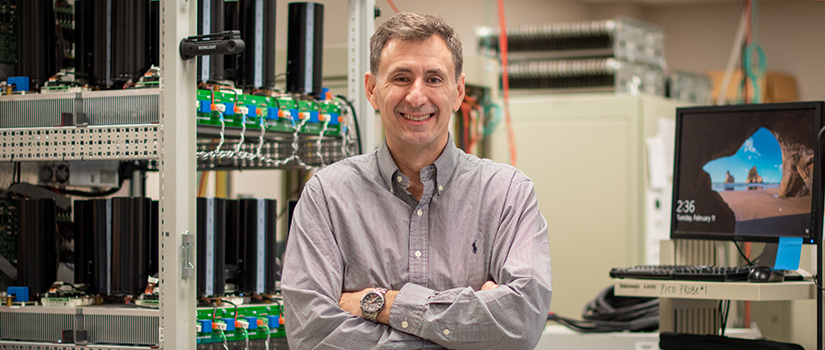In 2018, the U.S. Navy extended the life span of Arleigh Burke class destroyers to 45 years as part of a plan to increase their fleet to 355 ships by the late 2030s. The Navy is interested in advanced control systems for the next generation of surface combatants as they extend the lifespan of current ships and prepare for a larger fleet. One example is an advanced control that can determine if energy can be shared between different loads that require significant electrical power.
Electrical Engineering Professor Herbert Ginn is currently expanding on previous control systems research by being part of a larger effort toward deploying advanced controls. Ginn’s two-year, $500,000 research project, “Robust Combat Power Controls (RCPC)” is funded by the Office of Naval Research. Joining the College of Engineering and Computing on the RCPC project is Florida State University, the University of Texas at Arlington, the U.S. Naval Academy, Johns Hopkins University and Clarkson University. The work will also be done in partnership with the Naval Surface Warfare Center in Philadelphia.
It’s exciting to see how much we can use control and electronic power technologies to increase and manipulate the energy’s efficient use.
- Electrical Engineering Professor Herbert Ginn
Current Navy destroyers (DDG-51) have electrical loads with traditional armament missiles but a non-electric propulsion system. According to Ginn, the Navy is interested in an electric propulsion system and adding new weapons like railguns and lasers that require shared electrical energy to their newest destroyers (DG-1000).
“Previously, the destroyers had big gas turbines that drove the propulsion system. But today, that same turbine has an electric drive, which can divert the electrical energy from the drive to other high energy loads,” Ginn says. “The long-term vision of the Navy is to have some flexibility to route around damage with whatever energy is available.”
The RCPC project began earlier this year, and the goal is to determine how advanced control systems can be embedded into the current and future design of naval destroyers. Ginn’s research team is part of a larger consortium known as the Electric Ship Research and Development Consortium of Universities, which focuses on a multidisciplinary approach to the electric naval force system.
“It’s robust because these controls will allow the power system to provide service to as much of the ship as possible under various challenging operational conditions. We’re trying to figure out how we can squeeze out the most by application of advanced control systems,” Ginn says. “Advanced controls can also increase efficiency when not in battle. For example, stretching fuel longer for cruising is another benefit provided by advanced controls.”
Ginn’s research has focused on control evaluation framework over the last two years. He described the process as a method for determining the effectiveness of various competing control architectures, since some may perform better than others in different scenarios. Ginn used a hardware-in-the-loop technique, which helps to develop and verify complex real-time systems. The controls were connected to hardware-in-the-loop simulation by an electronic interface to simulate a real environment. Those same techniques will now be used for expanding the control evaluation framework and demonstrating advanced control design.
“Hardware-in-the-loop gives you the results based on a model of the actual system and provides inputs and outputs for control systems. You’ve basically tricked the control system into thinking it's connected to real equipment instead of a simulation,” Ginn says. “Our framework was how to set up a simulation environment and scenarios for these kinds of advanced control systems. We also had to automate it so we could run these scenarios through the different controls before effectiveness based on Navy metrics.”
Ginn also helped design some of the advanced controls for an energy magazine, which is a storage mechanism that supplies payload weapons with energy instead of being propellant or powder based. His research team is currently involving the advanced control design and evaluation of energy magazines using hardware-in-the-loop platforms.
Graduate research assistant and electrical engineering Ph.D. Candidate Md Multan Biswas will lead a sub-group dedicated to verification and validation testing of specialized power converters and energy magazines for electric shipboard power systems.
“My research team is developing new techniques for evaluating the behavior and operating boundaries of these specialized power converters and energy magazines under various disturbances and emergency scenarios during combat,” Biswas says. “In the next couple of decades, there will be a massive boost in the development of different power converters to use renewable energy, energy storage systems, and electric transportation charging stations.”
While Ginn’s research is currently only for the U.S. Navy, the RCPC project is a forerunner for the greater utility industry. He believes the Department of Defense projects often lead to other industry developments.
“A lot of the same technology that allows them to manipulate energy in a very flexible way for ship systems is used to interface renewables,” Ginn says. “Neighborhoods may have more interconnections with renewables. It’s exciting to see how much we can use control and electronic power technologies to increase and manipulate the energy’s efficient use.”
